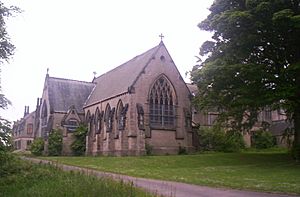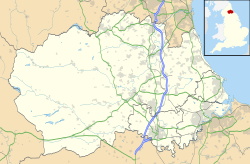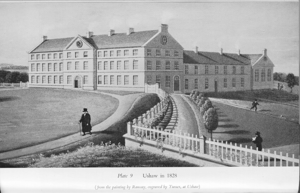Ushaw College facts for kids
Quick facts for kids Ushaw: Historic House, Chapels & Gardens |
|
|---|---|
| Formerly Ushaw College | |

St Aloysius' Chapel
|
|
| 54°47′17″N 1°39′40″W / 54.78818°N 1.66116°W | |
| Location | Ushaw Moor, Durham |
| Country | UK |
| Denomination | Roman Catholic |
| History | |
| Former name(s) | English College, Douai |
| Status | Theological College |
| Founded | September 29, 1568 |
| Founder(s) | Bishop William Gibson |
| Dedication | Saint Cuthbert |
| Consecrated | September 1808 |
| Architecture | |
| Functional status | Closed as college, open as visitor attraction |
| Heritage designation | Grade II with parts Grade II* and St Michael's Chapel Grade I |
| Designated | 17 January 1967 (main block and college chapel; other parts, including St Michael's Chapel, added 24 June 1987) |
| Architect(s) | James Taylor Dunn and Hansom |
| Style | Gothic Revival |
| Groundbreaking | 23 April 1804 |
| Completed | 2 August 1808 |
| Closed | June 2011 |
| Administration | |
| Parish | St Joseph's, Ushaw Moor |
| Deanery | St Cuthbert |
| Episcopal area | Sunderland and East Durham |
| Diocese | Hexham and Newcastle |
| Province | Liverpool |
Ushaw College (also known as St Cuthbert's College, Ushaw) is a historic place near Ushaw Moor, County Durham, England. It used to be a special school called a Catholic seminary. This is where people trained to become priests. Today, Ushaw is a popular place for visitors. It has beautiful old buildings, including chapels built in the Victorian Gothic style.
The college was started in 1808. Its founders were scholars who had to leave France because of the French Revolution. From 1968, Ushaw College worked closely with Durham University. It was the main place in northern England for training Catholic priests.
In 2011, the college stopped training priests because fewer people wanted to become priests. It then reopened in 2014 as a place for visitors. It is now called Ushaw: Historic House, Chapels & Gardens. About 50,000 people visit Ushaw each year. Parts of the college are also used by County Durham Music Service and Durham University.
Contents
History of Ushaw College
How Ushaw Started
The story of Ushaw College began with the English College, Douai. This college was founded in 1568 in France. But in 1795, its students and teachers had to leave France. This happened because of the French Revolution, a big change in France's government.
Some of the college members first stayed at Crook Hall near Durham. Then, in 1804, a leader named Bishop William Gibson began building a new college at Ushaw Moor. These first buildings were designed by James Taylor. They opened in 1808 as St Cuthbert's College.
Over the years, Ushaw College grew a lot. Many new buildings were added for the increasing number of students.
- In 1847, a new chapel designed by Augustus Welby Northmore Pugin opened.
- The Big Library and Exhibition Hall were built between 1849 and 1851. Joseph Hansom designed them.
- The Junior House, for younger students, was added in 1859 by Peter Paul Pugin.
- A larger chapel, St Cuthbert's Chapel, opened in 1884. It was designed by Dunn and Hansom. It replaced the older chapel because the college needed more space.
- The Refectory (dining hall) was designed by E. W. Pugin.
- In the early 1960s, a new East wing was built. This added more classrooms and bedrooms for 75 students.
Many of Ushaw's main buildings are very old and important. They are listed as Grade II historic buildings. The College Chapel is Grade II*, and the Chapel of St Michael is Grade I. This means they are protected because of their special history and design.
Ushaw and Durham University
Even though Ushaw College was its own school, it worked closely with Durham University. In 1968, Ushaw became a special "Licensed Hall of Residence" for the university. This meant that students at Ushaw could take courses that were approved by Durham University. Both future priests and other students studied there.
In 1972, the Junior House, which was for younger students, closed. Those students moved to another college in Lancashire.
Ushaw Today
In 2002, Ushaw College decided not to join another college near Birmingham. However, in 2010, it was announced that Ushaw College would close in 2011. This was because fewer people were choosing to become priests in the Roman Catholic Church.
After the college closed, people worked to find a new use for the site. In 2012, Durham Business School moved into the college temporarily. This was the first step in a plan to keep the site used for education.
Durham University also agreed to help organize and protect Ushaw's large library and other collections. The goal was to create a special center for Catholic history and learning. In 2019, a very old document from King John was found in the library!
In 2017, Durham University shared plans to create an international research library at Ushaw. This would bring scholars from all over the world to study the collections. The university has also extended its agreement to use the east wing of the college until 2027. Ushaw College is now also a place for many music events and lectures.
In 2018, Durham University's Centre for Evaluation and Monitoring (CEM) moved into the east wing. This shows how Ushaw continues to be an important place for learning and community.
What Does Ushaw's Shield Mean?
The college has its own special shield or "armorial bearings." These symbols tell a story about the college's history.
- The three rabbits (called "coneys") come from the family shield of William Allen. He was the person who founded the English College, Douai, which Ushaw College came from. You can learn more about the Three hares symbol.
- The small cross of St Cuthbert represents the college's special patron saint. It looks like St Cuthbert's own cross, which is kept at Durham Cathedral.
- The large cross of St George honors the English Roman Catholic Martyrs. These were people who died for their faith in England.
Famous People Who Studied at Ushaw
Many important people studied at Ushaw College over the years. Here are some of them:

Clergy (Church Leaders)
- Nicholas Cardinal Wiseman – the first Archbishop of Westminster
- Francis Cardinal Bourne – Archbishop of Westminster
- Arthur Cardinal Hinsley – Archbishop of Westminster
- William Cardinal Godfrey – Archbishop of Westminster
- John Carmel Cardinal Heenan – Archbishop of Westminster
- Rafael Cardinal Merry del Val y Zulueta – a very important Cardinal in the Vatican
- Charles Petre Eyre – Archbishop of Glasgow
- Louis Charles Casartelli – 4th Bishop of Salford
- Hugh Lindsay – 10th Bishop of Hexham and Newcastle
- James Chadwick – 2nd Bishop of Hexham and Newcastle
- Alexander Goss – Bishop of Liverpool
- Thomas Grant – Bishop of Southwark
- Mark Davies, Bishop of Shrewsbury
- John Lingard – author of a famous book about English history
- Bernard Łubieński - a missionary priest
- John Furniss – a priest known for his work with children
- James Nugent – a priest from Liverpool
- Nicholas Rigby – a priest and author
- Constantine Scollen – an Irish missionary priest and amazing linguist in Canada
- Paul Swarbrick - Bishop of Lancaster
Lay (People Not in the Church)
- George Goldie – an architect who designed many churches
- Edward Goldie – another architect who designed churches
- Alexander Martin Sullivan – an Irish lawyer
- Charles Napier Hemy – an artist
- Francis Thompson – an English poet
- Joseph Gillow – an author who wrote about English Roman Catholics
- William Shee – the first Roman Catholic judge in England and Wales since the Reformation
- Francis Joseph Sloane (aka Francesco Giuseppe Sloane) - a tutor at Ushaw and friend of Cardinal Wiseman
- Paul Goggins – a Member of Parliament
- Joseph Scott – a lawyer in Los Angeles
- A.J. Hartley – a bestselling novelist and Shakespeare expert
- Lafcadio Hearn (also known as Koizumi Yakumo) – an author famous for his books about Japan
- Francis Petre - a New Zealand architect
- Peter Paul Pugin – an English architect
- James Joseph Foy – a political figure in Ontario
- Myles William Patrick O'Reilly – a soldier and politician
- Archibald Matthias Dunn – an architect who designed churches
- Joe Tasker - a famous Himalayan climber
- Charles Bruzon – a government minister in Gibraltar



